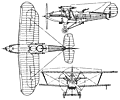 |
Hawker Audax1932 |  |
| SCHOOL, RECON | Virtual Aircraft Museum / United Kingdom / Hawker |
 |
Early experience with the Hart day bomber in squadron service left little doubt that it would prove suitable for adaptation to fulfil a variety of roles. One of the first involved fairly minor changes to satisfy an Army cooperation requirement, with the RAF needing a replacement for lower-performance but highly successful Armstrong Whitworth Atlas and Westland Wapiti aircraft. For this role the Hart was provided with a message pick-up hook and other equipment changes. About 652 Audax biplanes were ordered for the RAF, including those purchased by South Africa and those transferred to Malaya for the Straits Settlement Volunteer Air Force. Others were constructed for Persia (with Bristol Pegasus and Pratt & Whitney Hornet engines), Iraq, Canada, Singapore and Egypt - the latter with Armstrong Whitworth Panther X engines and supplied to allow Egypt to share with Britain the defence of Egypt, the Sudan and the Canal zone under the terms of the Anglo-Egyptian Treaty. RAF Audaxes entered service in 1932 and some based overseas were still flying in 1941-42. This fact is verified from records kept by British Aerospace, which state that an Audax squadron was used as fighter cover at the Digboi air station in north east Assam, India in 1942. However most of the remaining Audaxes were operated during the early war years as Hotspur glider tugs and trainers, 18 having previously been converted into Hart Specials.
|  COMPANY PROFILE | ||||||||||||||||||||||||||||||||||||||||||||||||||||||||||||
 |

|

